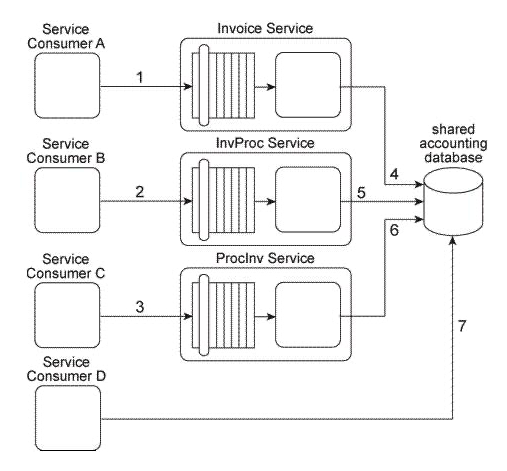Our service inventory contains the following three services that provide invoice-related data access capabilities: Invoice, InvProc, and Proclnv. These services were created at different times by different project teams and were not required to comply to any design standards. Therefore each of these services has a different data model for representing invoice data. Currently each of these three services has one service consumer: Service Consumer A accesses the Invoice service(1) . Service Consumer B (2) accesses the InvProc service, and Service Consumer C (3) accesses the Proclnv service. Each service consumer invokes a data access capability of an invoice-related service, requiring that service to interact with the shared accounting database that is used by all invoice-related services (4, 5, 6) . Additionally, Service Consumer D was designed to access invoice data from the shared accounting database directly (7) . (Within the context of this architecture. Service Consumer D is labeled as a service consumer because it is accessing a resource that is related to the illustrated service architectures.)  A project team recently proclaimed that it has successfully applied the Contract Centralization pattern to the service inventory in which the Invoice service, InvProc service, and ProcInv service reside. Upon reviewing the previously described architecture you have doubts that this is true. After voicing your doubts to a manager, you are asked to provide specific evidence as to why the Contract Centralization is not currently fully applied. Which of the following statements provides this evidence?
A project team recently proclaimed that it has successfully applied the Contract Centralization pattern to the service inventory in which the Invoice service, InvProc service, and ProcInv service reside. Upon reviewing the previously described architecture you have doubts that this is true. After voicing your doubts to a manager, you are asked to provide specific evidence as to why the Contract Centralization is not currently fully applied. Which of the following statements provides this evidence?
Definitions:
Safety Precaution
Measures taken in advance to prevent accidents or harm to people's health in various settings.
Disposable Gloves
Gloves made of various materials used once to protect hands from contamination and then disposed of.
Infecting Other Patients
The unintentional transmission of pathogens from one patient to another, typically occurring in healthcare settings.
Medical Assistant
A healthcare professional who supports doctors and nurses by performing administrative and clinical tasks in medical settings.
Q7: You want to visibly verify FC port
Q13: Sheela is told to prepare a report
Q18: The distinct ownership and governance requirements introduced
Q19: Communication tools for the Business Analyst include:<br>A)
Q19: How many items will be added to
Q28: Which of the following statements accurately describes
Q36: What is different about how network traffic
Q58: The IT planning department has asked for
Q134: The arrangements by which pools manage separate
Q202: is the price in a hypothetical transaction